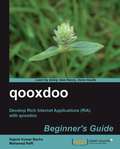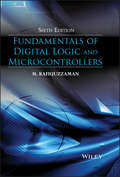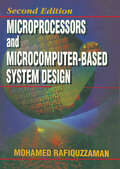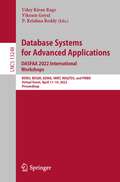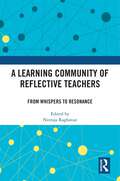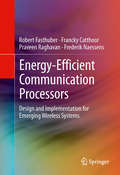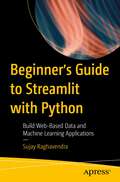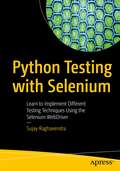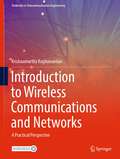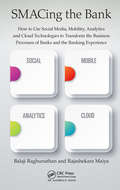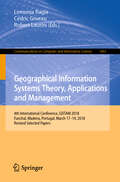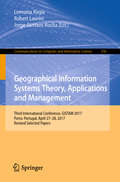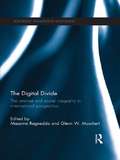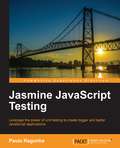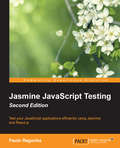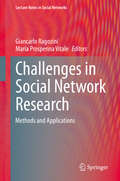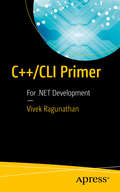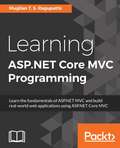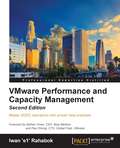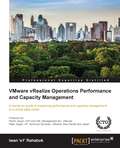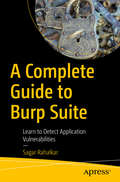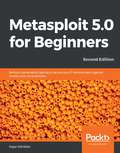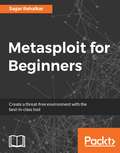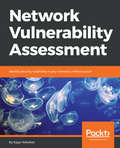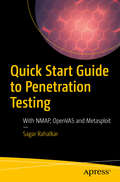- Table View
- List View
qooxdoo Beginner's Guide
by Mohamed Raffi Rajesh Kumar BachuThis is a Packt beginner's guide. The unique style of the book is to set the requirements for an application, Team Twitter, in the first chapter and apply the concepts in the application as you learn in the following chapters. When you complete this book, you would have developed a complete application. Although the scope of this book is only on the Qooxdoo framework, which is a client side framework, we have explained how to set up one of the RPC servers and demonstrated the end to end application in the Team Twitter. This book is intended for the client side developers who design and develop internet web applications and enterprise web applications. If you want to start developing RIA applications in Qooxdoo, this book would be a great help to jump start your development. If you are already developing Qooxdoo applications, this book will help you to go through the Qooxdoo framework quickly to improve your contribution to your project. This book is also intended for the desktop application developers who want to move into RIA development and develop internet web applications and rich enterprise web applications. It also provides an idea for the Architects and Lead developers to know about Qooxdoo and evaluate the framework. It helps beginners in Qooxdoo to easily set up the development environment and explains the concepts in an order that is easily graspable by beginners.
Fundamentals of Digital Logic and Microcontrollers
by M. RafiquzzamanReviews of the Fifth Edition:"...a well-established text for undergraduate and graduate students...a good reference for engineers." (IEEE Circuits & Devices Magazine, November/December 2006)"...will serve very well for a number of courses in electrical and computing engineering...can also be used as a reference by practicing engineers who want to know about microcomputers." (Computing Reviews.com, December 14, 2005)"Long recognized for its clear and simple presentation of the principles and basic tools required to design typical digital systems..." (IEEE Computer Magazine, August 2005)While technological change advancing at such a rapid pace, it should come as no surprise that microcontrollers are playing an increasingly important role in the design of digital systems. An understanding of the basic principles of microcontrollers is just one of the enhancements featured in the 6th Edition of Fundamentals of Digital Logic and Microcontrollers. Widely praised by both students and experts alike for its clear and simple presentation of the basic principles and necessary tools required to design typical digital systems, this new edition is entirely updated and revised to reflect the latest advances in contemporary digital design. The text's primary focus remains on computer design at the device, logic, and system levels while covering such basic points as number systems and Boolean algebra, combinational and sequential logic design. More advanced topics such as computer architecture and microcontroller-based applications are also addressed. Simplified coverage of basic concepts associated with CPLDs and FPGAs is included. Fundamentals of Digital Logic and Microcontrollers, 6th Edition, solidifies its reputation as the most invaluable and accessible introduction to the principles of digital system design available today.Numerous examples are provided throughout the text, including a complete tutorial for compiling and debugging a C-Program using the MPLAB. A solutions manual is available to instructors who adopt this text for a university course.
Microprocessors and Microcomputer-Based System Design
by Mohamed RafiquzzamanMicroprocessors and Microcomputer-Based System Design, Second Edition, builds on the concepts of the first edition. It discusses the basics of microprocessors, various 32-bit microprocessors, the 8085 microprocessor, the fundamentals of peripheral interfacing, and Intel and Motorola microprocessors. This edition includes new topics such as floating-point arithmetic, Program Array Logic, and flash memories. It covers the popular Intel 80486/80960 and Motorola 68040 as well as the Pentium and PowerPC microprocessors. The final chapter presents system design concepts, applying the design principles covered in previous chapters to sample problems.
Database Systems for Advanced Applications. DASFAA 2022 International Workshops: BDMS, BDQM, GDMA, IWBT, MAQTDS, and PMBD, Virtual Event, April 11–14, 2022, Proceedings (Lecture Notes in Computer Science #13248)
by Uday Kiran Rage Vikram Goyal P. Krishna ReddyThis volume constitutes the papers of several workshops which were held in conjunction with the 27th International Conference on Database Systems for Advanced Applications, DASFAA 2022, held as virtual event in April 2022. The 30 revised full papers presented in this book were carefully reviewed and selected from 65 submissions. DASFAA 2022 presents the following five workshops: · First workshop on Pattern mining and Machine learning in Big complex Databases (PMBD 2021) · 6th International Workshop on Graph Data Management and Analysis (GDMA 2022) · First International Workshop on Blockchain Technologies (IWBT2022) · 8th International Workshop on Big Data Management and Service (BDMS 2022) · First workshop on Managing Air Quality Through Data Science · 7th International Workshop on Big Data Quality Management (BDQM 2022).
A Learning Community of Reflective Teachers: From Whispers to Resonance
by Neeraja RaghavanTeachers possess a wealth of untapped wisdom and valuable experience. Whether it’s in matter of educational policy, curriculum development or textbook selection, teachers carry a trove of information and insights to share. Traditionally, teacher development has been driven by administrators of schools, and it often takes the form of a ‘mentor’ teaching the staff of a school. But what happens when teachers across different locations collaborate and learn together? This volume documents such an initiative, sparked off by the Covid-19 pandemic, which brought people together online. It underscores the power of teachers debating, discussing, and learning from each other. Based on an Indian experience, the book addresses a range of issues teachers and educators face across the world — encompassing pedagogy, classroom management, school culture and teacher development. A unique story of community building and teacher education, this book also contains key outcomes and insights which take us through their action research projects and showcases a model of teacher development that can be adopted by interested readers. Above all, it brings out the crying need for a teacher’s voice to be heard — for far too long, teachers have been mere implementers of decisions taken by policy makers or managements of schools. By means of networking communities such as the one described in this book, the transformation of teachers going from whispers to resonance is greatly amplified. An important intervention in the domain of teacher development, this volume will be of great interest to students, researchers and practitioners of education, teacher education, and sociology of education. It will also be useful for teacher trainees, academicians, teacher educators, policymakers, schoolteachers, curriculum developers, teacher training institutes, and universities offering teacher education programs.
Energy-Efficient Communication Processors
by Praveen Raghavan Francky Catthoor Frederik Naessens Robert FasthuberThis book describes a new design approach for energy-efficient, Domain-Specific Instruction set Processor (DSIP) architectures for the wireless baseband domain. The innovative techniques presented enable co-design of algorithms, architectures and technology, for efficient implementation of the most advanced technologies. To demonstrate the feasibility of the author's design approach, case studies are included for crucial functionality of advanced wireless systems with increased computational performance, flexibility and reusability. Designers using this approach will benefit from reduced development/product costs and greater scalability to future process technology nodes.
Beginner's Guide to Streamlit with Python: Build Web-Based Data and Machine Learning Applications
by Sujay RaghavendraThis book will teach you the basics of Streamlit, a Python-based application framework used to build interactive dashboards and machine learning web apps. Streamlit reduces development time for web-based application prototypes of data and machine learning models. As you’ll see, Streamlit helps develop data-enhanced analytics, build dynamic user experiences, and showcases data for data science and machine learning models. Beginner's Guide to Streamlit with Python begins with the basics of Streamlit by demonstrating how to build a basic application and advances to visualization techniques and their features. Next, it covers the various aspects of a typical Streamlit web application, and explains how to manage flow control and status elements. You’ll also explore performance optimization techniques necessary for data modules in a Streamlit application. Following this, you’ll see how to deploy Streamlit applications on various platforms. The book concludes with a few prototype natural language processing apps with computer vision implemented using Streamlit. After reading this book, you will understand the concepts, functionalities, and performance of Streamlit, and be able to develop dynamic Streamlit web-based data and machine learning applications of your own. What You Will Learn How to start developing web applications using Streamlit What are Streamlit's components Media elements in Streamlit How to visualize data using various interactive and dynamic Python librariesHow to implement models in Streamlit web applicationsWho This Book Is ForProfessionals working in data science and machine learning domains who want to showcase and deploy their work in a web application with no prior knowledge of web development.
Python Testing with Selenium: Learn to Implement Different Testing Techniques Using the Selenium WebDriver
by Sujay RaghavendraImplement different testing techniques using Selenium WebDriver with the Python programming language. This quick reference provides simple functional test cases with a syntax-based approach for Selenium WebDriver. You’ll begin by reviewing the basics of Selenium WebDriver and its architectural design history and then move on to the configuration and installation of Selenium library for different web browsers, including the basic commands needed to start test scripts in various browsers. You’ll review action commands of keyboard and mouse for testing user interactions in a web page and see how hyperlinks are tested. The book also examines various web elements using eight different locators provided by Selenium to help you choose the one best suited to your needs. All Python scripts are ready to test real examples, all of which are explained thoroughly with problem statements. You’ll use different Python design patterns to automate test scripts that can be incorporated with Selenium. In the end, Python Testing with Selenium will provide you with the expertise to write your own test cases in future. What You’ll Learn Install and configure Selenium WebDriver with Python for different web-browsers Review basic commands of Selenium Locate web elements Work with UI based web elements Assert web elements and handle exceptions Write test scripts in Page Object Model Write test cases with Unittest framework Who This Book Is For Python developers/testers who want to test their web applications
Introduction to Wireless Communications and Networks: A Practical Perspective (Textbooks in Telecommunication Engineering)
by Krishnamurthy RaghunandanThis book provides an intuitive and accessible introduction to the fundamentals of wireless communications and their tremendous impact on nearly every aspect of our lives. The author starts with basic information on physics and mathematics and then expands on it, helping readers understand fundamental concepts of RF systems and how they are designed. Covering diverse topics in wireless communication systems, including cellular and personal devices, satellite and space communication networks, telecommunication regulation, standardization and safety, the book combines theory and practice using problems from industry, and includes examples of day-to-day work in the field. It is divided into two parts – basic (fundamentals) and advanced (elected topics). Drawing on the author’s extensive training and industry experience in standards, public safety and regulations, the book includes information on what checks and balances are used by wireless engineers around the globe and address questions concerning safety, reliability and long-term operation. A full suite of classroom information is included.
SMACing the Bank: How to Use Social Media, Mobility, Analytics and Cloud Technologies to Transform the Business Processes of Banks and the Banking Experience
by Balaji Raghunathan Rajashekara MaiyaThe formula for the Future of Work is called SMAC - social, mobile, analytics and cloud on one integrated stack where each function enables another to maximize its effect. This is the new enterprise IT model delivering an organization that is more connective, collaborative, real time and productive. This book provides a comprehensive view of how SMAC Technologies are impacting the entire banking "eco-system" as well as the key stakeholders, namely customers, employees and partners.
Geographical Information Systems Theory, Applications and Management: 4th International Conference, GISTAM 2018, Funchal, Madeira, Portugal, March 17–19, 2018, Revised Selected Papers (Communications in Computer and Information Science #1061)
by Lemonia Ragia Cédric Grueau Robert LauriniThis book constitutes the thoroughly refereed proceedings of the 4th International Conference on Geographical Information Systems Theory, Applications and Management, GISTAM 2018, held in Funchal, Madeira, Portugal, in March 2018.The 7 revised full papers presented were carefully reviewed and selected from 58 submissions. The papers are centered on urban and regional planning; water information systems; geospatial information and technologies; spatio-temporal database management; decision support systems; energy information systems; GPS and location detection.
Geographical Information Systems Theory, Applications and Management (Communications in Computer and Information Science #936)
by Lemonia Ragia Robert Laurini Jorge Gustavo RochaThis book constitutes extended, revised and selected contributions from the Second International Conference on Geographical Information Systems Theory, Applications and Management, GISTAM 2016, held in Rome, Italy, in April 2016. The 10 papers presented in this volume were carefully reviewed and selected from a total of 33 submissions. They contribute to the understanding of relevant trends of current research on the topic, including urban and regional planning; water information systems; geospatial information and technologies; spatio-temporal database management; decision support systems; energy information systems; GPS, and location detection.
The Digital Divide: The Internet and Social Inequality in International Perspective (Routledge Advances in Sociology)
by Massimo Ragnedda Glenn W. MuschertThis book provides an in-depth comparative analysis of inequality and the stratification of the digital sphere. Grounded in classical sociological theories of inequality, as well as empirical evidence, this book defines ‘the digital divide’ as the unequal access and utility of internet communications technologies and explores how it has the potential to replicate existing social inequalities, as well as create new forms of stratification. The Digital Divide examines how various demographic and socio-economic factors including income, education, age and gender, as well as infrastructure, products and services affect how the internet is used and accessed. Comprised of six parts, the first section examines theories of the digital divide, and then looks in turn at: Highly developed nations and regions (including the USA, the EU and Japan); Emerging large powers (Brazil, China, India, Russia); Eastern European countries (Estonia, Romania, Serbia); Arab and Middle Eastern nations (Egypt, Iran, Israel); Under-studied areas (East and Central Asia, Latin America, and sub-Saharan Africa). Providing an interwoven analysis of the international inequalities in internet usage and access, this important work offers a comprehensive approach to studying the digital divide around the globe. It is an important resource for academic and students in sociology, social policy, communication studies, media studies and all those interested in the questions and issues around social inequality.
Jasmine JavaScript Testing
by Paulo RagonhaThe book uses a concise, to-the-point approach to help developers understand and use the power of Jasmine to create better and more maintainable codebases.This book is a must-have guide for web developers who are new to the concept of unit testing. It's assumed that you have a basic knowledge of JavaScript and HTML.
Jasmine JavaScript Testing - Second Edition
by Paulo RagonhaThis book is for web developers and designers who work with React.js and JavaScript and who are new to unit testing and automation. It's assumed that you have a basic knowledge of JavaScript and HTML.
Challenges in Social Network Research: Methods and Applications (Lecture Notes in Social Networks)
by Giancarlo Ragozini Maria Prosperina VitaleThe book includes both invited and contributed chapters dealing with advanced methods and theoretical development for the analysis of social networks and applications in numerous disciplines. Some authors explore new trends related to network measures, multilevel networks and clustering on networks, while other contributions deepen the relationship among statistical methods for data mining and social network analysis. Along with the new methodological developments, the book offers interesting applications to a wide set of fields, ranging from the organizational and economic studies, collaboration and innovation, to the less usual field of poetry. In addition, the case studies are related to local context, showing how the substantive reasoning is fundamental in social network analysis. The list of authors includes both top scholars in the field of social networks and promising young researchers. All chapters passed a double blind review process followed by the guest editors. This edited volume will appeal to students, researchers and professionals.
C++/CLI Primer: For .NET Development
by Vivek RagunathanEnter a world of hardcore back-end, server-side enterprise programming on the . NET platform. This book presents some of the important aspects of the C++/CLI language that often become a barrier preventing programmers from exploring further. The C++/CLI Primer is a powerful but compact book that will guide you through that barrier. Many of today's complex transactions and enterprise applications count on C++/CLI. Visual Studio 2015 and earlier versions support C++/CLI if you program using an IDE. C++/CLI is unattractive, clumsy, and hard when compared to other modern languages that run on the . NET platform. That's because it is powerful. Like light that can be viewed as a wave or particle, C++/CLI can be exercised as an unmanaged or managed or actually as the sandwich language to do mixed mode programming, which is its real power. That's also why it is unique. What You'll Learn Discover C++/CLI and why is it used in . NET programming Work with types, primitive types, object creation, and managed and abstract classes Use abstract classes in C++/CLI Harness the power of nullptre Implement code that uses boxing/unboxing Use equality/identity, properties, enums, strings, arrays, and more Who This Book Is For Experienced Microsoft . NET application developers, familiar with . NET framework and C++.
Learning ASP.NET MVC Programming
by Mugilan T. RagupathiThis book is for developers who want to learn to build web applications using ASP.Net MVC 6, developers who want to make a career building web applications using Microsoft technology, and developers who are working in Ruby on Rails or other web frameworks and want to learn ASP.Net MVC6. No knowledge of the ASP.Net platform or the .Net platform is required. Even though you do not need to have experience in C#, an understanding of the basic constructs (loops, conditionals, classes, and objects) of any modern programming language would be helpful.
VMware Performance and Capacity Management - Second Edition
by Iwan 'E1' RahabokMaster SDDC Operations with proven best practices About This Book * Understand the drawbacks of the traditional paradigm and management that make operations difficult in SDDC * Master performance and capacity management in Software-Defined Data Center * Operationalize performance and capacity monitoring with proven dashboards Who This Book Is For This book is primarily for any system administrator or cloud infrastructure specialist who is interested in performance management and capacity management using VMware technologies. This book will also help IT professionals whose area of responsibility is not VMware, but who work with the VMware team. You can be Windows, Linux, Storage, or Network team; or application architects. Note that prior exposure to the VMware platform of data-center and cloud-based solutions is expected. What You Will Learn * Simplify the task of performance and capacity management * Master the counters in vCenter and vRealize Operations and understand their dependency on one another * Educate your peers and management on SDDC Operations * Complete your SDDC monitoring to include non-VMware components * Perform SDDC performance troubleshooting * Explore real-life examples of how super metric and advanced dashboards * Introduce and implement a Performance SLA * Accomplish your Capacity Management by taking into service tiering and performance SLA In Detail Performance management and capacity management are the two top-most issues faced by enterprise IT when doing virtualization. Until the first edition of the book, there was no in-depth coverage on the topic to tackle the issues systematically. The second edition expands the first edition, with added information and reorganizing the book into three logical parts. The first part provides the technical foundation of SDDC Management. It explains the difference between a software-defined data center and a classic physical data center, and how it impacts both architecture and operations. From this strategic view, it zooms into the most common challenges--performance management and capacity management. It introduces a new concept called Performance SLA and also a new way of doing capacity management. The next part provides the actual solution that you can implement in your environment. It puts the theories together and provides real-life examples created together with customers. It provides the reasons behind each dashboard, so that you get the understanding on why it is required and what problem it solves. The last part acts as a reference section. It provides a complete reference to vSphere and vRealize Operations counters, explaining their dependencies and providing practical guidance on the values you should expect in a healthy environment. Style and approach This book covers the complex topic of managing performance and capacity in an easy-to-follow style. It relates real-world scenarios to topics in order to help you implement the book's teachings on the go.
VMware vRealize Operations Performance and Capacity Management
by Iwan 'E1' RahabokIf you are an IT professional who is interested in performance management and capacity management in a virtual data center, then this book is ideal for you. The book is an intermediate-level book.
A Complete Guide to Burp Suite: Learn to Detect Application Vulnerabilities
by Sagar RahalkarUse this comprehensive guide to learn the practical aspects of Burp Suite—from the basics to more advanced topics. The book goes beyond the standard OWASP Top 10 and also covers security testing of APIs and mobile apps. Burp Suite is a simple, yet powerful, tool used for application security testing. It is widely used for manual application security testing of web applications plus APIs and mobile apps. The book starts with the basics and shows you how to set up a testing environment. It covers basic building blocks and takes you on an in-depth tour of its various components such as intruder, repeater, decoder, comparer, and sequencer. It also takes you through other useful features such as infiltrator, collaborator, scanner, and extender. And it teaches you how to use Burp Suite for API and mobile app security testing.What You Will Learn Understand various components of Burp Suite Configure the tool for the most efficient use Exploit real-world web vulnerabilities using Burp Suite Extend the tool with useful add-onsWho This Book Is ForThose with a keen interest in web application security testing, API security testing, mobile application security testing, and bug bounty hunting; and quality analysis and development team members who are part of the secure Software Development Lifecycle (SDLC) and want to quickly determine application vulnerabilities using Burp Suite
Metasploit 5.0 for Beginners: Perform penetration testing to secure your IT environment against threats and vulnerabilities, 2nd Edition
by Sagar RahalkarA comprehensive guide to Metasploit for beginners that will help you get started with the latest Metasploit 5.0 Framework for exploiting real-world vulnerabilities Key Features Perform pentesting in highly secured environments with Metasploit 5.0 Become well-versed with the latest features and improvements in the Metasploit Framework 5.0 Analyze, find, exploit, and gain access to different systems by bypassing various defenses Book Description Securing an IT environment can be challenging, however, effective penetration testing and threat identification can make all the difference. This book will help you learn how to use the Metasploit Framework optimally for comprehensive penetration testing. Complete with hands-on tutorials and case studies, this updated second edition will teach you the basics of the Metasploit Framework along with its functionalities. You'll learn how to set up and configure Metasploit on various platforms to create a virtual test environment. Next, you'll get hands-on with the essential tools. As you progress, you'll learn how to find weaknesses in the target system and hunt for vulnerabilities using Metasploit and its supporting tools and components. Later, you'll get to grips with web app security scanning, bypassing anti-virus, and post-compromise methods for clearing traces on the target system. The concluding chapters will take you through real-world case studies and scenarios that will help you apply the knowledge you've gained to ethically hack into target systems. You'll also discover the latest security techniques that can be directly applied to scan, test, ethically hack, and secure networks and systems with Metasploit. By the end of this book, you'll have learned how to use the Metasploit 5.0 Framework to exploit real-world vulnerabilities. What you will learn Set up the environment for Metasploit Understand how to gather sensitive information and exploit vulnerabilities Get up to speed with client-side attacks and web application scanning using Metasploit Leverage the latest features of Metasploit 5.0 to evade anti-virus Delve into cyber attack management using Armitage Understand exploit development and explore real-world case studies Who this book is for If you are a penetration tester, ethical hacker, or security consultant who wants to quickly get started with using the Metasploit Framework to carry out elementary penetration testing in highly secured environments, then this Metasploit book is for you. You will also find this book useful if you're interested in computer security, particularly in the areas of vulnerability assessment and pentesting, and want to develop practical skills when using the Metasploit Framework.
Metasploit for Beginners: Perform Penetration Testing To Secure Your It Environment Against Threats And Vulnerabilities, 2nd Edition
by Sagar RahalkarAn easy to digest practical guide to Metasploit covering all aspects of the framework from installation, configuration, and vulnerability hunting to advanced client side attacks and anti-forensics. About This Book • Carry out penetration testing in highly-secured environments with Metasploit • Learn to bypass different defenses to gain access into different systems. • A step-by-step guide that will quickly enhance your penetration testing skills. Who This Book Is For If you are a penetration tester, ethical hacker, or security consultant who wants to quickly learn the Metasploit framework to carry out elementary penetration testing in highly secured environments then, this book is for you. What You Will Learn • Get to know the absolute basics of the Metasploit framework so you have a strong foundation for advanced attacks • Integrate and use various supporting tools to make Metasploit even more powerful and precise • Set up the Metasploit environment along with your own virtual testing lab • Use Metasploit for information gathering and enumeration before planning the blueprint for the attack on the target system • Get your hands dirty by firing up Metasploit in your own virtual lab and hunt down real vulnerabilities • Discover the clever features of the Metasploit framework for launching sophisticated and deceptive client-side attacks that bypass the perimeter security • Leverage Metasploit capabilities to perform Web application security scanning In Detail This book will begin by introducing you to Metasploit and its functionality. Next, you will learn how to set up and configure Metasploit on various platforms to create a virtual test environment. You will also get your hands on various tools and components used by Metasploit. Further on in the book, you will learn how to find weaknesses in the target system and hunt for vulnerabilities using Metasploit and its supporting tools. Next, you'll get hands-on experience carrying out client-side attacks. Moving on, you'll learn about web application security scanning and bypassing anti-virus and clearing traces on the target system post compromise. This book will also keep you updated with the latest security techniques and methods that can be directly applied to scan, test, hack, and secure networks and systems with Metasploit. By the end of this book, you'll get the hang of bypassing different defenses, after which you'll learn how hackers use the network to gain access into different systems. Style and approach This tutorial is packed with step-by-step instructions that are useful for those getting started with Metasploit. This is an easy-to-read guide to learning Metasploit from scratch that explains simply and clearly all you need to know to use this essential IT power tool.
Network Vulnerability Assessment: Identify security loopholes in your network’s infrastructure
by Sagar RahalkarBuild a network security threat model with this comprehensive learning guideKey FeaturesDevelop a network security threat model for your organizationGain hands-on experience in working with network scanning and analyzing toolsLearn to secure your network infrastructureBook DescriptionThe tech world has been taken over by digitization to a very large extent, and so it’s become extremely important for an organization to actively design security mechanisms for their network infrastructures. Analyzing vulnerabilities can be one of the best ways to secure your network infrastructure.Network Vulnerability Assessment starts with network security assessment concepts, workflows, and architectures. Then, you will use open source tools to perform both active and passive network scanning. As you make your way through the chapters, you will use these scanning results to analyze and design a threat model for network security. In the concluding chapters, you will dig deeper into concepts such as IP network analysis, Microsoft Services, and mail services. You will also get to grips with various security best practices, which will help you build your network security mechanism.By the end of this book, you will be in a position to build a security framework fit for an organization.What you will learnDevelop a cost-effective end-to-end vulnerability management programImplement a vulnerability management program from a governance perspectiveLearn about various standards and frameworks for vulnerability assessments and penetration testingUnderstand penetration testing with practical learning on various supporting tools and techniquesGain insight into vulnerability scoring and reportingExplore the importance of patching and security hardeningDevelop metrics to measure the success of the vulnerability management programWho this book is forNetwork Vulnerability Assessment is for security analysts, threat analysts, and any security professionals responsible for developing a network threat model for an organization. This book is also for any individual who is or wants to be part of a vulnerability management team and implement an end-to-end robust vulnerability management program.
Quick Start Guide to Penetration Testing: With NMAP, OpenVAS and Metasploit
by Sagar RahalkarGet started with NMAP, OpenVAS, and Metasploit in this short book and understand how NMAP, OpenVAS, and Metasploit can be integrated with each other for greater flexibility and efficiency. You will begin by working with NMAP and ZENMAP and learning the basic scanning and enumeration process. After getting to know the differences between TCP and UDP scans, you will learn to fine tune your scans and efficiently use NMAP scripts. This will be followed by an introduction to OpenVAS vulnerability management system. You will then learn to configure OpenVAS and scan for and report vulnerabilities. The next chapter takes you on a detailed tour of Metasploit and its basic commands and configuration. You will then invoke NMAP and OpenVAS scans from Metasploit. Lastly, you will take a look at scanning services with Metasploit and get to know more about Meterpreter, an advanced, dynamically extensible payload that is extended over the network at runtime.The final part of the book concludes by pentesting a system in a real-world scenario, where you will apply the skills you have learnt.What You Will LearnCarry out basic scanning with NMAPInvoke NMAP from PythonUse vulnerability scanning and reporting with OpenVASMaster common commands in MetasploitWho This Book Is ForReaders new to penetration testing who would like to get a quick start on it.
